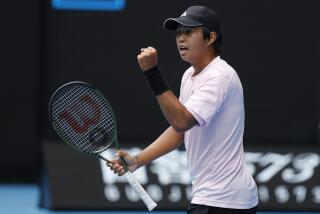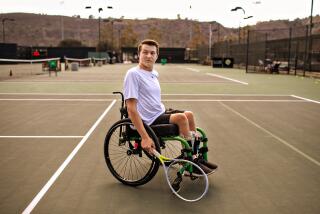48 Years Later, He’s Starting to Find Potential
- Share via
It came on suddenly, the loss of motor function, the intense, burning pain.
One day in 1940, Glenn Hippenstiel, a junior at California, was one of the nation’s top collegiate tennis players. The next, he couldn’t pick up a cup of coffee.
It took the doctors more than a year to diagnose the cause: Kineboch’s Syndrome, a rare disease about which little is known even now. But the effects were quickly apparent. His once-powerful right arm became limp.
“Before it happened, I knew that I would be the best player in the world,” Hippenstiel said. “I thought it would just be a matter of time until I reached my potential.”
Perhaps it was just a matter of time. How about 48 years?
Now 68, Hippenstiel, who lives in Fresno, long ago abandoned his dream of becoming the best player in the world. That distinction belongs to the young, and to those with two good arms. But as he helped the 65-and-over United States team win the Davis Cup-styled Britannia Cup with a 3-0 victory over France Friday at Lindborg Racquet Club in Huntington Beach, Hippenstiel continued to chase his potential.
He uses both arms now. When the disease crippled him, he stubbornly refused to let it stop him. He learned to play left-handed. As the years passed, the effects of the disease diminished, restoring some of the power in his right arm. It came in handy about 16 years ago when, in a back-yard basketball game with his kids, he broke his left arm.
“Because of that, I tried playing some right-handed for the first time in 30 years,” he said. “I did pretty well. After my (left) arm healed, it seemed natural for me to play with both hands, because I didn’t really have enough power in either one to be competitive.”
It doesn’t look natural.
“I don’t want to say it looks weird,” said David Martin, his friend and frequent doubles partner. “But it’s pretty unorthodox.”
But effective, very effective.
The U.S. already had clinched its 10th straight Britannia Cup with singles victories by Martin and Tom Brown, when Hippenstiel and John McGrath took Lindborg’s center court for the doubles match.
The U.S. won in straight sets, 6-2, 6-4, though Hippenstiel did not make his part look easy.
Playing the net, the ball comes his way and he gently drops a two-handed forehand for a winner. Playing the baseline, he waits for a lob and smashes a two-handed overhead for a winner.
“The truth is,” Martin said, “Glenn’s grip gives him some advantages. It’s so difficult to read. He can wait until the last moment and just crush it. Plus, it gives him a more steady, even stroke.”
One thing is clear, his partners say. Playing with Hippenstiel is no handicap.
“This is the first time I had played with him,” McGrath said, “And I guess it is an unusual looking style. But nobody says we have to look pretty. I’m kind of a choppy hitter myself. Glenn’s got a strange approach. But it works.”
When Hippenstiel retired from his job as an administrator with the California Department of Transportation five years ago, he became a regular on the amateur senior circuit.
Over the years, he has won or shared 13 age-group national championships. He and Martin are the country’s third-ranked 65-and-over doubles team. Two weeks ago at a tournament in Santa Barbara, they beat the No. 1 team, Tom Brown and Bobby Riggs.
“We want to become No. 1,” he said.
Hippenstiel has learned to work around many weaknesses. In 1980, the joint of his left hip was replaced with steel, which limits his mobility. His eyesight is diminishing, too.
“As far as mobility, I’m like a snail compared to what I once was,” he said. “I can’t move very well to my left, and that’s as much mental as anything. The physical act I can do, but I’m supposed to take it easy. So I don’t try to dive for shots that I would have 10 years ago. I lose some points that way.
“My eyes are getting worse every year, but I’ll make it. I’ve got a friend who has just one eye, and there’s a lot he doesn’t see. But he hits what he sees. I figure if I hit what I see, I’ll be all right.”
Hippenstiel’s handicaps would make it difficult for him to be a top senior singles player, though he does play singles “just to stay in shape.” But the strengths he has developed to circumvent those weaknesses make him what Martin calls the “perfect doubles player.”
“What you can say about Glenn,” Martin said, “is that he does what he can and doesn’t worry about what he can’t do.”
Hippenstiel doesn’t even think about quitting. He has overcome every obstacle in his path, and that has given him a feeling of invincibility.
“It was my dream to be the best in this game,” he said. “I never got the chance to realize that potential, but at least I can realize what potential I have now. It may not be half of what it once was, but it’s more than some ever have.
“Tennis really means something to me. In everyday life, you can go out and try to win, but you never reach the outcome. You never find out how well you’ve done until it’s over. In tennis, you can go out and sweat and run and think, and in a couple of hours, it’s over. The matter’s settled. Going out and proving something, it means something to me.”
More to Read
Go beyond the scoreboard
Get the latest on L.A.'s teams in the daily Sports Report newsletter.
You may occasionally receive promotional content from the Los Angeles Times.










